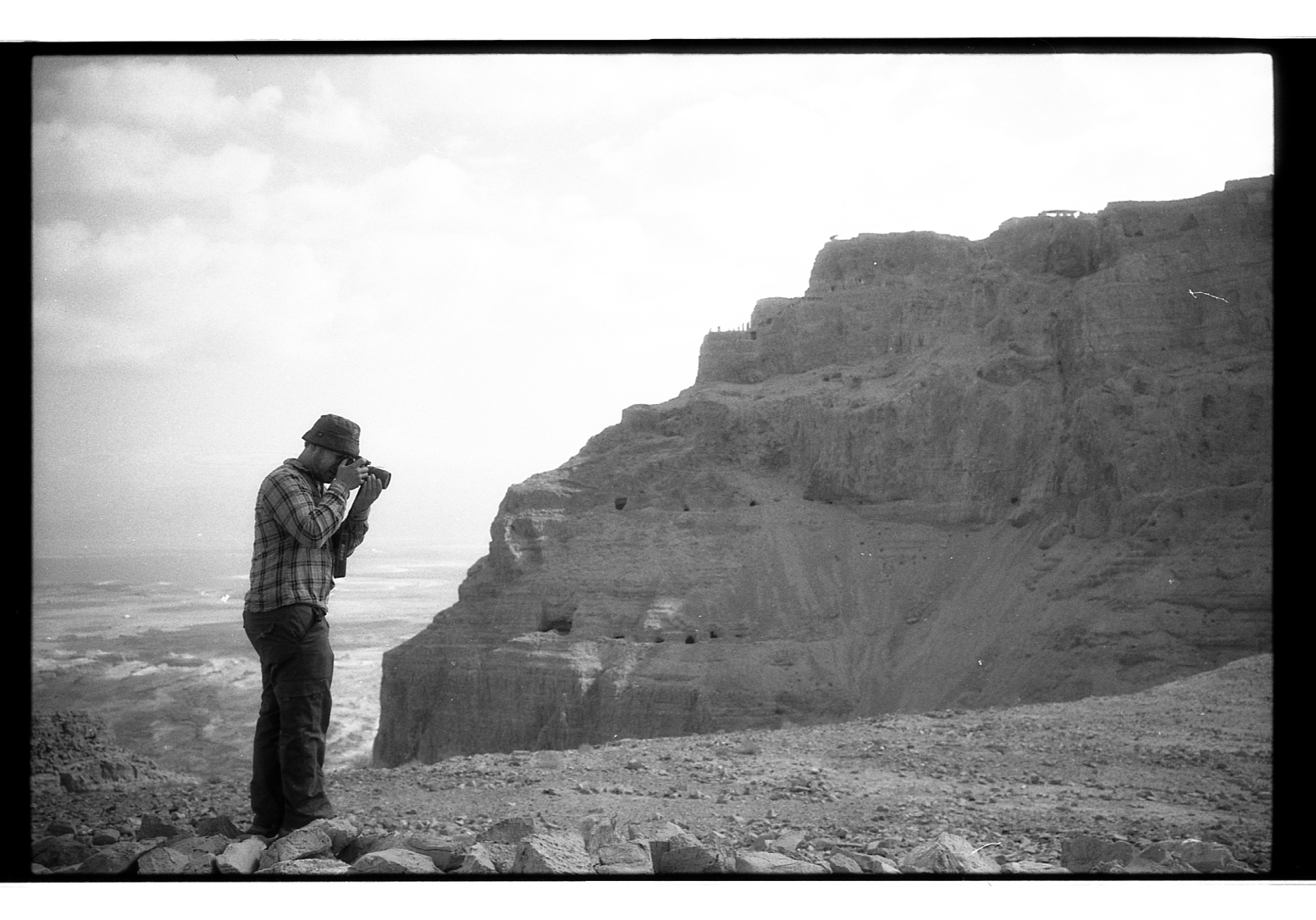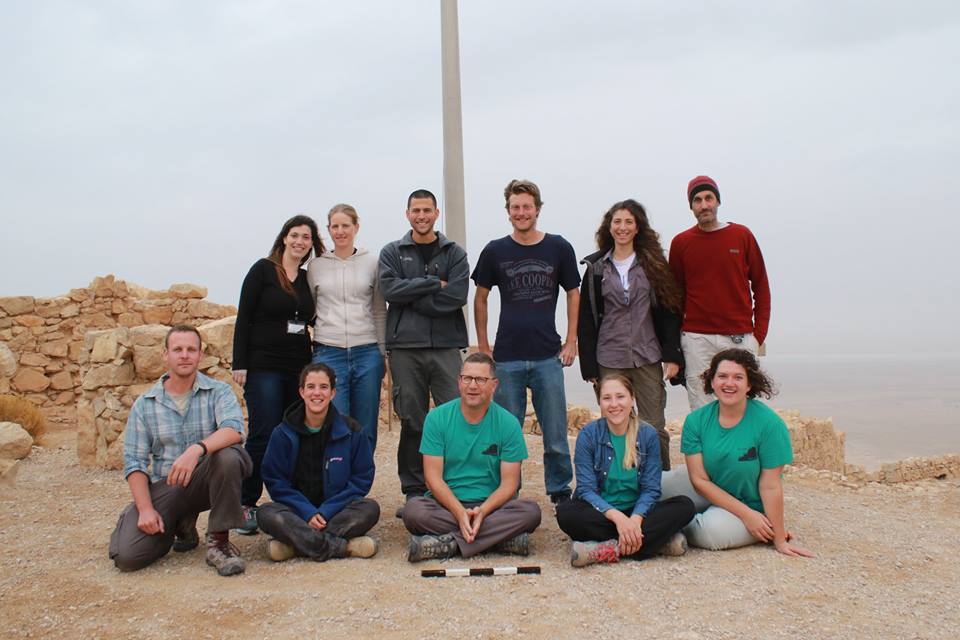国王之水 - 大希律王在马萨达的水资源管理
New Discoeries at Shijiahe - a Central Prehistoric Settlement in the Middle Yangzi Region
Guy D. Stiebel
盖尔·斯迪拜
Tel Aviv University
以色列特拉维夫大学
2017年二月,由盖尔·斯迪拜博士所带领的以色列特拉维夫大学的考古考察活动重返世界遗产遗址和马萨达国家公园。宫殿是由大希律王(公元前37-4年)在荒芜的朱迪亚沙漠中所建,靠近四海的西岸。在第一次反抗罗马人和著名的为围成时(公元73年),该处作为犹太反抗势力的避难所。犹太史学家约瑟夫(Flavius Josephus)在其Bellum Judaicum中详细记述了这处地点戏剧性的终结。公元5到7世纪,这里成为了拜占庭时期位于米迪亚沙漠中最遥远的基督教修道院。干旱的气候和偏远的位置使得该处遗址的建筑和其他一些物质文化材料保存的十分良好。该处遗址第一次被记录是1806年,1838年这里被认作是马萨达。20世纪60年代,由也丁·亚丁教授(Prof. Yigael Yadin)所领导的希伯来大学在这里进行了大量的发掘工作。在1989年和1995至2001年之间,更多的发掘在遗址的高原处进行。

专注于未发掘的区域,在马萨达6个新的发掘区中,有4个发掘区是由彼得和娜奥米·纽斯塔特考古探险队进行发掘。他们主要研究与大希律王有关的主题,如水的收集与装配,以及园艺。大希律王很可能是伟大的东罗马帝国的缔造者之一。在公元前一世纪的下半叶,他的统治象征着希腊和罗马文化风格之间的转变。在这期间,他向朱迪亚地区的引进了新趋势、设计和技术。在他的建筑中,最鲜为人知的是水技术和水的使用方式。建造沙漠宫殿堡垒的能力首先也是最重要的是基于收集和保存洪水的能力。丰富的水让国王的建筑师利用它们做建造矩阵和水池,同时可以用来维持沙漠中巨大的私人花园,并使精细农业得以存在。本项目为这些方面的研究提供了初步的观察。
我们本次的考古工作主要关注与几个有关活动的方面:遗址周围和遗址内的谁管理,以及在山顶宫殿中井的使用。先进的拍照测量技术(包括无人机的使用)为我们提供了遗址及周边的三维模型。该项技术除了测算和收集建筑筑材料的体量外,它还能给我们提供一个有关水收集系统的精确记录,以及水被带入这个遗址中的轨迹记录。因此,我们可以重新测算“流道痕迹”的年代,最近我们才知道它处于罗马围城时期。然而,对于新发现部分的详细记录显示它的建造年代是大希律王时期。同时在小径上还发现了几只驮兽的铁鞋。新的测年导致了约瑟夫希腊文本一种新的解读,这显然表明我们发现了这处遗址“西方因素上升”的情形,这点在古代历史学家的记述中一般表现为由希律王所建造(BJ 7.289)。未来的探测计划主要是提取光释光(OSL)的样品,从而能够为我们提供更为准确的年代信息。作为梯田测年计划的一部分之一,在过去的5年间,以色列的同时正在进行。

水的可用性使希律王在他的宫殿里提供了一个新的组成部分,即休闲时间概念的引入:佳境(locus amoenus)。皇家公园在干燥隔绝的地方出现并繁荣其阿里,最主要是归功于流行与希律王时期先进且复杂的水管理系统,它可以为当地的居民提供40000 m3的水量!同时在山顶山还建造有石坝、水渠和蓄水池。因此在马萨达高原上发现有三个洗浴场所和一个游泳池并不奇怪。最近对1924年英国皇家空军(RAF)的老航拍照片分析暗示可能还有两个蓄水池的存在。由于玻璃底片的发展,我们在遗址中心的位置发现了这两个蓄水池,这些蓄水池还包括了一些重要装置的水管道。大约半个世纪之后,这些蓄水池被拜占庭的隐士所重新使用,并在那里建造了一个laura。这一活动不仅在古代史料中有所提及,而且还得到了物质文化的进一步支持。
正如上述所示,希律王在马萨达沙漠地区过渡使用水的情形,通过园艺无疑得到了最好的体现。约瑟夫的记录暗示马萨达很可能作为皇家园林和农业活动的场所:
为国王保留山顶,对于农业,其土壤比山谷儿更加富饶,所以当从外部获
取困难的时候,那些把他们的安全托付给要塞的人,不会因为这些困难而
变得穷困潦倒。(约瑟夫,犹太战争,7.288)

在试图发展可以允许我们对这种活动进行部分认知的科学工具和方法时,我们遇到了巨大的挑战。因此,皇家园林中关于希律王种植的情况和这个遗址内的植物状况的检测通过与特拉维夫大学Dafna Langgut博士的植物考古实验室的合作进行。我们划分采样和土壤样品分析,同时对微炭进行了研究。
利用Langgut等人(2013年)开发的技术,北部宫殿的上阶台的发掘中,我们成功的从地表以下1.2米深处的石膏结构中提取出了一些橄榄的花粉颗粒和葡萄。虽然还需要进一步的发掘和植物遗存的收集,从而使我们了解更为全面的景象,但就像Stiebel所提出的那样,这些初步的结果已经指向了在这个阶梯地区存在有viridarium。
在台地南部的发掘中,我们发现植物遗存似乎在农田中作为一种肥料的组成部分。此外,为了提取微炭残留,这些沉积物的样品已经被提取和分析。令我们惊讶的是,在上层与碳屑混合的土壤中还发现有葡萄的花粉颗粒。我们还设法确定了微炭的存在,相比于土壤的下层,土壤上层中所发现的数量更多,这暗示这肥料的持续使用。早期元首的古典作家,如Pliny the Elder和Columella,他们描述了将木炭和木灰作为某些作物肥料的情形。事实上,Pliny甚至暗示这些木灰对于葡萄的成熟有着很好的促进作用(Pliny the Elder, Natural History, 17.49)。更多的发掘将会检测在朱迪亚沙漠中,马萨达宫殿区的顶部是否存在有小型的葡萄园。
以色列一位著名诗人Yehuda Amichai,在为朱迪亚沙漠写过一本诗集—— Open Eyed Land。其中的一篇写到:
养蜂人不会将蜂房放在这里,但是人们有时会在这种荒芜的环境中获得到从比任何其他地方所获得的蜂蜜都要甜。
在这个世界上,全球变暖和缺水的威胁正变得越来越明显,了解干旱地区水资源的管理方法似乎与我们的社会有很大的关系。此外,对干旱气候进行适当调整的发现可能为古代农业和经济提供新的见解,并可能帮助一些现在已经灭绝的植物复苏。
In February 2017, the archaeological expedition of Tel-Aviv University, headed by Dr. Guy D. Stiebel, returned to the World Heritage site and National Park of Masada. The palatial fortress was built by King Herod the Great (37-4BC) amid the arid Judaean Desert, near the western shores of the Dead Sea. It became an asylum for Jewish rebels during the First Revolt against the Romans and the arena for a famous siege (AD73), whose dramatic ending was narrated in details by the historian Flavius Josephus in his account Bellum Judaicum. It later became the most remote Christian monastery in the Judaean Desert during the Byzantine period (5th-7th centuries AD). The arid climate and the remoteness of the site resulted in excellent preservation of the ruins, both in terms of architecture and especially that of its material culture. The site was first noted in 1806 and was identified with Masada in 1838. Extensive excavations were conducted at the site in the 1960s by the expedition of the HU of Jerusalem headed by Professor Yigael Yadin (1963-65). Further excavation on the site’s plateau at its foot took place in 1989 and between 1995-2001.
Conducted by the Peter and Naomi Neustadter archaeological expedition to Masada and focusing on unexplored areas, four of the six newly excavated areas at Masada were devoted to research themes connected to King Herod the Great — namely, water collection, water installation and gardening. The king had most likely been one of the greatest builders of the Roman East. His reign, in the second half of the 1st century BC, symbolizes the transition between Hellenistic and Roman influences, during which he introduced to Judaea a plethora of new trends, designs and technologies. One of the least explored aspects of his architecture is its water technology and the ways in which water was used. The capacity to build a chain of desert palatial fortresses was first and foremost based on his impressive ability to collect and preserve flash flood water. Water was so abundant that it became a matrix used by the king’s architects to feed his lavish installations and pools, sustain large and private gardens in the middle of the desert and enable the existence of boutique agriculture. The present project offers an intimate observation of this achievement.
Our expedition focuses on several circles and dimensions of activity: water management at the environs of the site and at the site, as well the usage of water on top of the mountain-top palace. An advanced photometric technique that involves the usage of a UAV (drone) was harnessed to provide the first scholarly 3D modelling of the site environ. In addition to gathering the volume of building material used, this documentation provided an accurate record of the water collecting system as well as the trails’ system through which water was brought to the site. As a result, we were able to re-date the “runner trail”, that had been thought until recently to date from the time of the Roman siege. Yet the identification and the meticulous documentation of the newly discovered part and stages of the trail indicated that it was constructed during the reign of King Herod. Several iron shoes of pack animals were found on the trail. The new date led to a new reading of the Greek text of Josephus, clearly suggesting that we have found the “Western Ascend” of the site that was noted by the ancient historian to be constructed by Herod (BJ 7.289). Future probes are planned to extract OSL (Optically Stimulated Luminescence) samples in an attempt to provide more accurate dates as part of the terraces’ dating project, undertaken by Israeli colleagues in the past five years.
The availability of water allowed King Herod to furnish his palace with an important ingredient of the newly introduced concept of leisure time: the locus amoenus. The fact that royal gardens flourished on top of the arid isolated site should be first and foremost attributed to the highly sophisticated and advanced water management that prevailed in Herod’s time and provided the site’s inhabitants with the staggering amount of 40,000 m3! Stone built dams, water channels and cisterns were constructed around and on the mountain’s top for that end. It is thus not surprising to find three bathhouses and one swimming pool on the plateau of Masada. A recent analysis of 1924’s RAF old aerial photographs hinted to the existence of two unknown water cisterns. Following the development of the glass negatives, we have identified and uncovered those two cisterns in the very centre of the site, including the water channels that fed those crucial installations. These cisterns were reused, some half a millennium later, by the Byzantine hermits that constructed a laura there. Not only was this activity mentioned in ancient historical sources but it was further supported by the site’s material culture.
As mentioned, Herod’s excessive use of water at the desert site of Masada was no doubt best demonstrated through horticulture. Josephus’s testimony hinted that Masada was a possible arena for royal gardening and agriculture activities:
Τὴν γὰρ κορυφὴν πίονα καὶ πεδίου παντὸς οὖσαν μαλακωτέραν ἀνῆκεν εἰς γεωργίαν ὁ βασιλεύς, ἵν᾽ εἴ ποτε τῆς ἔξωθεν τροφῆς ἀπορία γένοιτο, μηδὲ ταύτῃ κάμοιεν οἱ τὴν αὐτῶν σωτηρίαν τῷ φρουρίῳ πεπιστευκότες.
(Ἰώσηπος, Ἰωσήπου ἱστορία Ἰουδαϊκοῦ πολέμου πρὸς Ῥωμαίους βιβλία Ζ, 288)
For the king reserved the top of the hill, whose soil was rich and softer than any valley, for agriculture, so that if ever there arrived some difficulty in procuring provisions from the outside, those who had entrusted their safety to the fortress would not be made destitute by this hardship (Josephus, The Jewish War, 7.288)
This set before us a great challenge to develop scientific tools and methods that allow for the impartial identification of such activity and installations. Thus the prospect of Herodian cultivation of a royal garden and plantations at the site was examined in cooperation with a team from Dr. Dafna Langgut’s archaeobotanical laboratory at TAU. Advanced pollen sampling and analysis of soil samples has been employed as well as the examination of the microcharcoal remains.
Using the technique developed by Langgut et al. (2013), in excavating the Upper Terrace of the Northern Palace our team successfully extracted a few pollen grains of olive (Olea europaea) and grape (Vitis vinifera) from the plaster of a structure at a depth of 1.2m below current surface. Though further excavation and collection of botanical remains is required in order to reach a more comprehensive picture, these preliminary results appear to point to the presence of a viridarium in the terrace, as was proposed by Stiebel.
Excavating the southern part of the plateau, botanical remains were discovered seemingly forming components of the fertilizer used in this agricultural plot. In addition, samples of this sediment were collected and analyzed in order to extract micro-botanical remains. To our surprise, fossil pollen grains of grape (Vitis vinifera) were identified in the upper levels of the soil mixed with the charcoal. We also managed to identify the presence of micro-charcoal, graded such that they were present in greater numbers in the upper levels of the soil layer than in the lower levels, suggestive of the continuous use of ash fertilizer. Classical authors of the early Principate, such as Pliny the Elder and Columella, describe the use of charcoal and wood ash as valuable fertilizers for certain crops and plants. Pliny, in fact, even suggested that ash is particularly good for the ripening of grapes (Pliny the Elder, Natural History, 17.49). Further excavations will examine the possible existence of a small vineyard on top of the palatial fortress of Masada amidst the Judaean Desert.
One of Israel’s leading poets, Yehuda Amichai, dedicated a book of poems to the Judaean Desert – Open Eyed Land. There one may read:
No grower of bees
Would put his
Beehives here.
But people
Sometimes make honey from desolation
Sweeter than anything
In a world where the threats of global warming and water shortage are becoming ever more evident, an understanding of old methods of water management in arid zones appears to bear much relevance to our societies. Moreover, the discovery of well-adjusted species to arid climates may offer new insights about ancient agriculture and economy and possibly contribute to the potential revival of now extinct plants.
